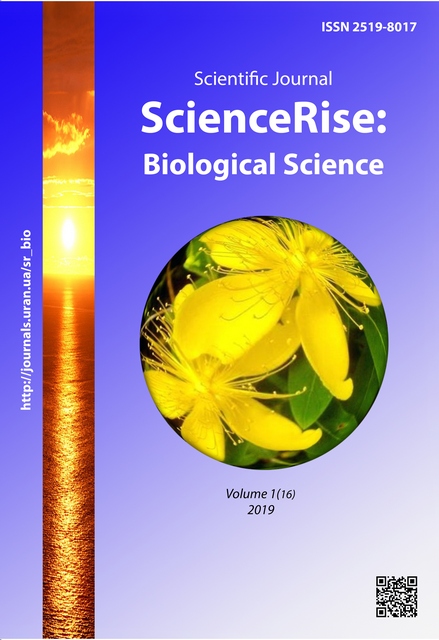Potential impact of cerium dioxide nanoparticles (nanoceria) on the concentration of C-reactive protein and middle-mass molecules after wound treatment in rats
DOI:
https://doi.org/10.15587/2519-8025.2019.159010Keywords:
C-reactive protein, Middle-mass molecules, Nanoceria, Gabrielyan method, turbidimetryAbstract
Wound healing which is a usual biological process in our body is attained by four accurate and highly organized stages: hemostasis, inflammation, proliferation, and remodeling. In order to achieve a proper and successful wound healing, all these stages must occur in an appropriate sequence under a certain period of time. Many factors can disturb one or more stage of this process, hence resulting an inappropriate or ruined wound healing.
Aim of research. This article investigates the influence of nanoceria on C-reactive protein and Middle-mass molecules concentration in blood serum of rats after full-thickness wound model.
Materials and Methods. These two factors are considered to be indicators for endogenous intoxication, thus controlling their level in blood serum plays a key role in the wound healing process. The experimental procedure was conducted by the Gabrielyan method for Middle-mass molecules (MMM) concentration measurement and turbidimetry for C-reactive protein.
Result. It was shown the elevated level of MMM in blood serum in the control group of rats. In contrast, where the treatment of wounds was carried out by Nanoceria in experimental group, the level of MMM decreased significantly in each day of experiment till 20th day when the full re-epithelialization occurred. And we demonstrated an increase in the level of CRP on the 3rd, 6th, 9th and 14th days of the experiment in comparison with the control in blood serum of all the experimental groups. Restoration of this indicator to normal values was observed in the groups of animals that received Nanoceria on the 20th day of the experiment, it correlated with full re-epithelialization.
Conclusion. Due to several other advantages of Nanoceria, such as balancing some growth factors, Antioxidant, Antimicrobial, ROS reduction, SOD restoration, Catalase reduction properties that were investigated and proved in our previous studies, we consider Nanoceria as a promising drug for further investigation
References
- Sproston, N. R., Ashworth, J. J. (2018). Role of C-Reactive Protein at Sites of Inflammation and Infection. Frontiers in Immunology, 9. doi: http://doi.org/10.3389/fimmu.2018.00754
- Pradhan, A. D., Manson, J. E., Rifai, N., Buring, J. E., Ridker, P. M. (2001). C-reactive protein, interleukin 6, and risk of developing type 2 diabetes mellitus. JAMA, 286 (3), 327–34. doi: http://doi.org/10.1001/jama.286.3.327
- Du Clos, T. W. (2000). Function of C-reactive protein. Annals of Medicine, 32 (4), 274–278. doi: http://doi.org/10.3109/07853890009011772
- Healy, B., Freedman, A. (2006). Infections. BMJ, 332 (7545), 838–841. doi: http://doi.org/10.1136/bmj.332.7545.838
- Kingsley, A., Jones, V. (2008). Diagnosing wound infection: the use of C-reactive protein. Wounds UK, 4 (4), 32–46.
- Mold, C., Nakayama, S., Holzer, T., Gewurz, H., Du Clos, T. (1981). C-reactive protein is protective against Streptococcus pneumoniae infection in mice. Journal of Experimental Medicine, 154 (5), 1703–1708. doi: http://doi.org/10.1084/jem.154.5.1703
- Ishchuk, T. V., Raetska, Y. B., Savchuk, O. M., Ostapchenko, L. I. (2015). Changes in blood protein composition under experimental chemical burns of esophageal development in rats. Biomedical Research and Therapy, 2 (4). doi: http://doi.org/10.7603/s40730-015-0009-x
- Chmielewski, M., Cohen, G., Wiecek, A., Carrero, J. J. (2014). The Peptidic Middle Molecules: Is Molecular Weight Doing the Trick? Seminars in Nephrology, 34 (2), 118–134. doi: http://doi.org/10.1016/j.semnephrol.2014.02.005
- Nikolskaya, V., Memetova, Z. (2013). Level of middle mass molecules in serum and mouth liquid in pregnant women in a state of hyperinsulinism and gestational diabetes mellitus. Scientific Notes of-Taurida National V. I. Vernadsky University. Series “Biology and Chemistry”, 26, 132–137.
- Tupikova, Z., Osipovich, V. (1990). The effect of middle molecules isolated from the serum of burn patients on the state of lipid peroxidation in animal tissues. Voprosy meditsinskoi khimii, 36 (3), 24–26.
- Val'dman, B. M., Volchegorskii, I. A., Puzhevskii, A. S., Iarovinskii, B. G., Lifshits, R. I. (1991). Middle-molecular peptides in blood as endogenous regulators of lipid peroxidation in the normal state and during thermal burns. Voprosy meditsinskoi khimii, 37 (1), 23–26.
- First national congress on Bioethics (2001). Weekly journal «Pharmacy», 308 (37).
- Gabrielyan, N. I., Dmitriev, A. A. (1985). Screening method of middle molecules in biological fluids. Moscow: Medicine, 18.
- Dolgov, V. V., Shevchenko, O. N., Sharyshev, A. A. et. al. (2007). Turbidimetry in laboratory practice. Moscow: Reafarm, 176.
- Neely, A. N., Brown, R. L., Clendening, C. E., Orloff, M. M., Gardner, J., Greenhalgh, D. G. (1997). Proteolytic activity in human burn wounds. Wound Repair and Regeneration, 5 (4), 302–309. doi: http://doi.org/10.1046/j.1524-475x.1997.50404.x
- Doucet, A., Overall, C. (2008). Protease proteomics: Revealing protease in vivo functions using systems biology approaches // Molecular Aspects of Medicine. Vol. 29, Issue 5. P. 339–358. doi: http://doi.org/10.1016/j.mam.2008.04.003
- Ulrich, D., Ulrich, F., Unglaub, F., Piatkowski, A., Pallua, N. (2010). Matrix metalloproteinases and tissue inhibitors of metalloproteinases in patients with different types of scars and keloids. Journal of Plastic, Reconstructive & Aesthetic Surgery, 63 (6), 1015–1021. doi: http://doi.org/10.1016/j.bjps.2009.04.021
Downloads
Published
How to Cite
Issue
Section
License
Copyright (c) 2019 Arefeh Amiri, Nataliia Nikitina, Lyidmila Stepanova, Tetiana Beregova

This work is licensed under a Creative Commons Attribution 4.0 International License.
Our journal abides by the Creative Commons CC BY copyright rights and permissions for open access journals.
Authors, who are published in this journal, agree to the following conditions:
1. The authors reserve the right to authorship of the work and pass the first publication right of this work to the journal under the terms of a Creative Commons CC BY, which allows others to freely distribute the published research with the obligatory reference to the authors of the original work and the first publication of the work in this journal.
2. The authors have the right to conclude separate supplement agreements that relate to non-exclusive work distribution in the form in which it has been published by the journal (for example, to upload the work to the online storage of the journal or publish it as part of a monograph), provided that the reference to the first publication of the work in this journal is included.









